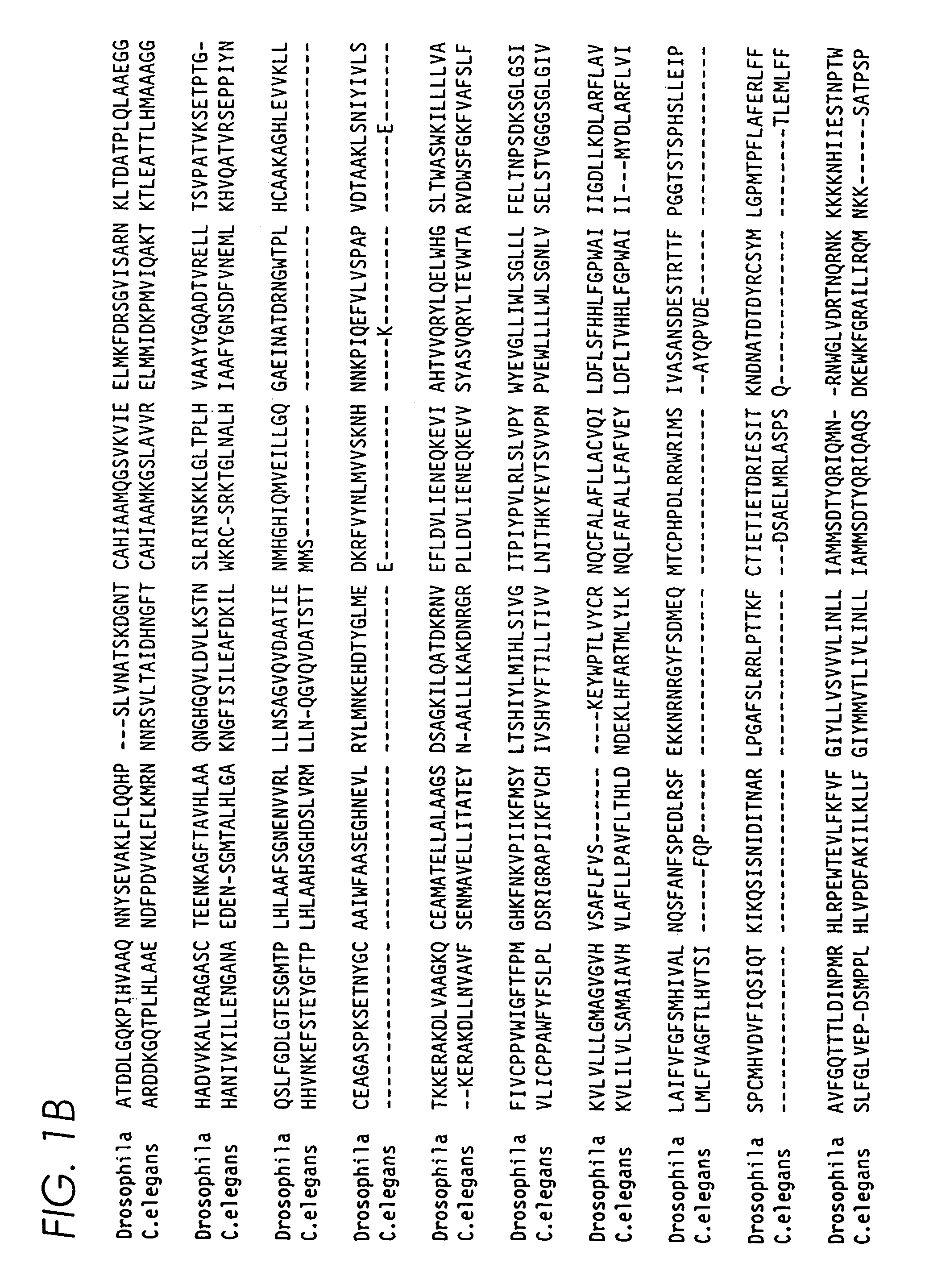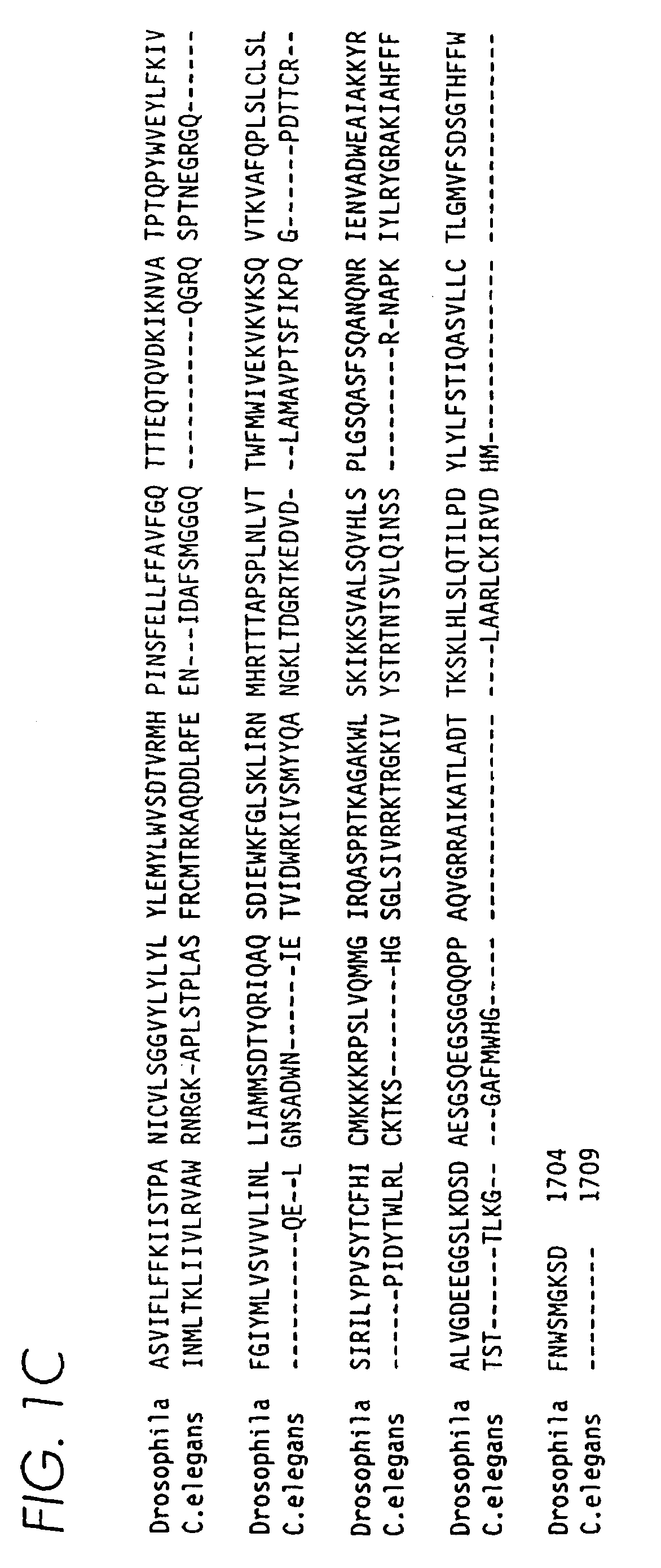In vitro method for identifying a compound using an eukaryotic mechanosensory transduction channel
a technology of compound, which is applied in the field of identifying compound using an eukaryotic mechanosensory ion channel, can solve the problem that the principle molecule of the mechanosensory transduction process in eukaryotes, the mechanically gated channel, has yet to be isolated or identified, and achieves the effect of modulating the activity of the mechanosensory receptor
- Summary
- Abstract
- Description
- Claims
- Application Information
AI Technical Summary
Benefits of technology
Problems solved by technology
Method used
Image
Examples
example i
Chromosome Mapping and Positional Cloning of MSC Genomic Region
[0248]To identify mutations with potential roles in mechanosensory transduction, a genetic screen was carried out to identify mutations in Drosophila melanogaster that result in uncoordination phenotypes. This screen yielded mutations in numerous genes. Further characterization of these mutations using electrophysiological methods determined that several of the genes also reduced or eliminated bristle mechanoreceptor potentials (Kernan et al., Neuron 12:1195-1206 (1994)). One of these mutations, responsible for the nompC (for no-mechanoreceptor potential), present on the second chromosome, abolished nearly all of the mechanoelectrical transduction in mutant cells. Flies with this mutation are uncoordinated to the point of lethality. Based on these phenotypes, the gene underlying the nompC mutant was identified as potentially encoding a protein playing a central role in mechanosensory transduction, such as a mechanosensor...
example ii
Sequencing of the Rescuing Cosmid and MSC Gene
[0251]To determine the sequence of the cosmid containing the MSC protein encoding gene, the genomic DNA insert from the cosmid was isolated, sonicated, polished, size-selected, and the resulting 0.7-2 kb fragments subcloned into plasmid vectors. Plasmids were purified and analyzed for the presence and size of inserts, and 123 clones with inserts of greater than 0.7 kb were sequenced. The sequences determined from these inserts were used to assemble large contiguous fragments, which were extended by designing ad hoc primers from the ends of the fragments and using the primers to read additional sequence from the cosmid DNA. In this way, the entire 33.6 kb cosmid insert was sequenced.
[0252]The MSC protein-encoding gene was identified and characterized within this 33.6 kb cosmid sequence using exon analysis, BLAST searches, and secondary-structure prediction programs. These analyses established that the MSC gene is a large gene comprised of...
example iii
Sequencing of nompC Mutants
[0253]To assess the molecular defects of the nompC mutants, we used PCR to amplify the genomic DNA encompassing the nompC locus from flies with one of four mutant nompC alleles. In this way, all four alleles of the nompC gene were amplified in approximately 2 kb fragments that covered the gene interval. These fragments were then sequenced. All four of the nompC alleles showed mutations in the coding region when compared to the sequence of the cosmid and to the parental, wild type DNA.
[0254]In three of these alleles, the nompC (MSC) polypeptide encoded by the mutant gene was prematurely truncated in the ankyrin repeats by the introduction of stop codons. The fourth allele had a missense mutation between transmembrane segments four and five, resulting in a C to Y substitution.
PUM
| Property | Measurement | Unit |
|---|---|---|
| Tm | aaaaa | aaaaa |
| temperature | aaaaa | aaaaa |
| temperature | aaaaa | aaaaa |
Abstract
Description
Claims
Application Information
 Login to View More
Login to View More - R&D
- Intellectual Property
- Life Sciences
- Materials
- Tech Scout
- Unparalleled Data Quality
- Higher Quality Content
- 60% Fewer Hallucinations
Browse by: Latest US Patents, China's latest patents, Technical Efficacy Thesaurus, Application Domain, Technology Topic, Popular Technical Reports.
© 2025 PatSnap. All rights reserved.Legal|Privacy policy|Modern Slavery Act Transparency Statement|Sitemap|About US| Contact US: help@patsnap.com



